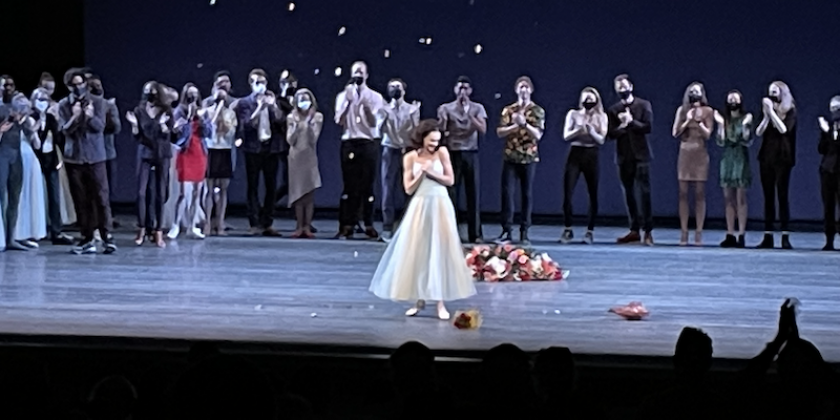The Dance Enthusiast Hits the Streets: Dance/NYC 2017 Symposium

This year, more so than in Symposiums past, there was a concrete, timely cause for action: New York City’s first cultural plan. Branded CreateNYC, this in-progress “roadmap for the future of NYC arts and culture” grounded Dance/NYC’s eighth annual industry gathering.
In her opening remarks, Betsy MacLean of our cultural planning partner Hester Street Collaborative heralded the “power of planning,” appealing to my left-brained comfort zone. Two hours later, the ever-artsy Damian Woetzel and Sphinx Organization President/Artistic Director Afa Dworkin dove deep in their “Conversation about the Future of Dance in America” into the rise of entrepreneurialism and new definition of success in the arts. This too felt relevant as I sat there with my dancer, dance teacher, arts admin, consultant, and press hats piled atop my head.
The day’s sessions in cultural planning, voices on race and dance, audience engagement, and more had us pivot from present to future, shifting our perspective from NYC dance to NYC arts to culture nationwide. There was a spirit of responsiveness throughout. This was driven by the upcoming July 1, 2017 cultural plan deadline and what seemed to be a conscious push beyond theorizing about our field’s challenges towards next steps.

As un-sexy as a city-developed cultural plan may sound, there’s an irony in the fact that NYC remains one of the only major metropolitan areas without one. Defining our culture, representing diverse viewpoints, and prioritizing our collective needs — it’s no small task. And it’s not a task reserved for the dance or arts community. It’s for all New Yorkers who have an appreciation for the role arts and culture plays in the “New York-ness” of their lives. (P.S. They play a pretty important role).
Department of Cultural Affairs (DCLA) Commissioner Tom Finkelpearl took the hot seat to discuss the task at hand as we wrap up the planning and public engagement phase in the coming months. He acknowledged recent criticisms that artists weren’t being heard, pointing to our day together (thanks, Dance/NYC!), partnerships with New York Foundation for the Arts and individual artists, and upcoming public events.
Diversity, equity, and inclusion emerged as necessary priorities for the plan. Report after report after report was highlighted by speakers, indicating a cultural sector less than representative of our diverse field, city, and nation. This is not a new Symposium conversation. But this time there was at least a specific place to direct concerns. And yet, as Woetzel and Dworkin’s conversation came to an end, one audience member stood up, “If you’re talking about the future of dance in America, to not have a voice of a person of color is problematic, at the very least.” She was right. We have more work to do.
So what has been done? The afternoon session, “Increasing Philanthropy’s Commitment to Diversity, Equity, and Inclusion” lent some insight. A diverse panel of funders talked us through the changes made in their priorities. Despite differing definitions of these values, the consensus was that there is a movement underway. Sage Crump of Leveraging A Network for Equity stated, “What we’re seeing looks a lot like organizing in the funding community. Where do our processes not create enough space to allow people to come to us for resources authentically as they are?”
Another session in which historical track records were used as a launch pad was “Designing the Future of Dance Education.” In looking at the first ever comparison of DCLA and Department of Education (DOE) data, I wasn’t shocked to see visual arts and music at the forefront of arts education programming, feeble as it is, with dance and theatre left in the proverbial dust.
The best part came in the ideas of how to do better. Dance education ambassador Jody Arnhold is launching what appears to be the first doctoral program in dance education in the United States. Paul L. King, of the DOE, stressed the value of approaching collaboration with public schools as mutual partnerships. Cathryn Williams, of Alvin Ailey American Dance Theatre, spoke about knowledge sharing when it comes to available capital funding for schools to improve their dance space. And Ana Nery Fragoso, of the DOE, highlighted demand, “Our kids need to see more process. So if you invite us, we’ll go.”

Arts education is clearly another desired priority for the plan. Michelle T. Boone, who led Chicago’s cultural plan effort, shared, “The number one thing people wanted was arts education.” Still, the pervading message from Boone and her peers on the “National Perspectives on Cultural Planning” panel was the importance of thoughtful implementation of the plan. This echoed Finkelpearl’s earlier point, “July 1 is the beginning. Really. It has to be the beginning.”
I left the Symposium reflecting on the task at hand and that to come once a cultural plan is in place. Woetzel’s words on entrepreneurialism came to mind, “It’s simply about taking a step back occasionally and saying, where’s my entry point?” We’ve been given an entry point and invited to collaborate to change our City’s culture for the better. Let’s take this opportunity, shall we? Visit CreateNYC.org to learn more and participate.












